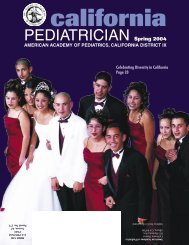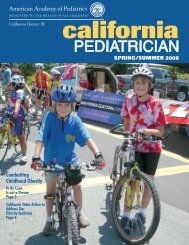PEDIATRICIAN Spring 2003 - AAP-CA
PEDIATRICIAN Spring 2003 - AAP-CA
PEDIATRICIAN Spring 2003 - AAP-CA
You also want an ePaper? Increase the reach of your titles
YUMPU automatically turns print PDFs into web optimized ePapers that Google loves.
TWENTY-FIVE YEARS OF HOME MECHANI<strong>CA</strong>L VENTILATION IN CHILDREN CONTINUED FROM PAGE 21<br />
ventilation. We generally keep the end-tidal<br />
Pco 2<br />
at values between 30-35 torr at all times<br />
to provide the children with some respiratory<br />
reserve in the event of an illness. It is imperative<br />
that each child has a general pediatrician<br />
participate in her overall care.<br />
Mechanical ventilation is not always a<br />
life-long therapy. Some of the children may<br />
be weaned from ventilation depending on<br />
the underlying lung disease. The types of<br />
patients that can be weaned include those with<br />
chronic lung disease and some children with<br />
ventilatory muscle weakness. The process of<br />
weaning, also known as “sprinting,” should<br />
be gradual, with brief periods of time breathing<br />
spontaneously off the ventilator. These are<br />
progressively increased as long as the patient<br />
tolerates the changes. The tolerance of the<br />
weaning regimen can be assessed clinically<br />
and objectively by means of oximetry and<br />
carbon dioxide monitoring. These children are<br />
weaned during waking hours first and should<br />
be able to tolerate this regimen before considering<br />
changes in nighttime ventilation.<br />
The goals of home ventilation are: 1) to<br />
ensure medical safety, 2) prevent and minimize<br />
complications, 3) optimize quality of life and<br />
rehabilitation potential, and 4) reintegrate the<br />
child back into the family. The success of a<br />
home ventilator program is dependent on the<br />
dedicated and integrated services provided by<br />
the hospital and the community. Once an infant<br />
or child is deemed to need home mechanical<br />
ventilation, the coordinated effort for transition<br />
from hospital to home is dependent on<br />
multiple factors including: the availability of<br />
ventilators, the education of the parents, and<br />
the availability of home nursing. Criteria for<br />
discharge to home are: medical stability with<br />
stable ventilatory settings, family commitment<br />
to home care, education of parents regarding<br />
technical aspects of care of children with<br />
mechanical ventilation, adequate home care<br />
environment (power, telephone and electricity),<br />
access to emergency services, and vendor<br />
services as well as access to a pediatrician.<br />
Local pulmonary services should be consulted<br />
to help plan the process of implementing ventilatory<br />
support.<br />
In summary, home ventilation has<br />
approached a new era with many changes in<br />
the last 25 years. With the new technology,<br />
children with severe lung disease are able to<br />
live at home and reintegrate into their families<br />
with a reasonably good quality of life. The<br />
transition from hospital to home is possible<br />
with more portable technology and with the<br />
dedication of all those involved in the program,<br />
in the hospital and in the community.<br />
Address Correspondence to:<br />
Thomas G. Keens, M.D.<br />
Division of Pediatric Pulmonology<br />
Childrens Hospital Los Angeles<br />
4650 Sunset Boulevard, Box #83<br />
Los Angeles, California 90027-6062<br />
Phone: 323/669-2101<br />
FAX: 323/664-9758<br />
E-Mail: tkeens@chla.usc.edu<br />
Head to Toe: Orthopaedic Aspects of the Growing Child.<br />
Orthopaedic problems are a common cause of concern for parents and a frequent reason for<br />
visiting the primary care provider. The evaluation and treatment of these problems is rapidly<br />
evolving. This course will focus on orthopaedic problems commonly encountered by primary<br />
care physicians (pediatricians and family practitioners), including congenital abnormalities of the<br />
hip and feet, fractures, sports injuries, and developmental deformities such as lower extremity<br />
bowing and leg length discrepancies. Participants will have the opportunity to actively discuss<br />
these problems with experts in the field.<br />
SATURDAY, October 18, <strong>2003</strong><br />
7:30 am to 4:30 pm<br />
Cedars-Sinai Medical Center<br />
Harvey Morse Auditorium<br />
8701 Gracie Allen Drive<br />
Los Angeles, California<br />
For additional information call the Office of Continuing Medical Education at<br />
(310) 423-5548 or 423-2935; you may also email: stokes@cshs.org<br />
<strong>CA</strong>LIFORNIA <strong>PEDIATRICIAN</strong> — SPRING <strong>2003</strong>/ 27








